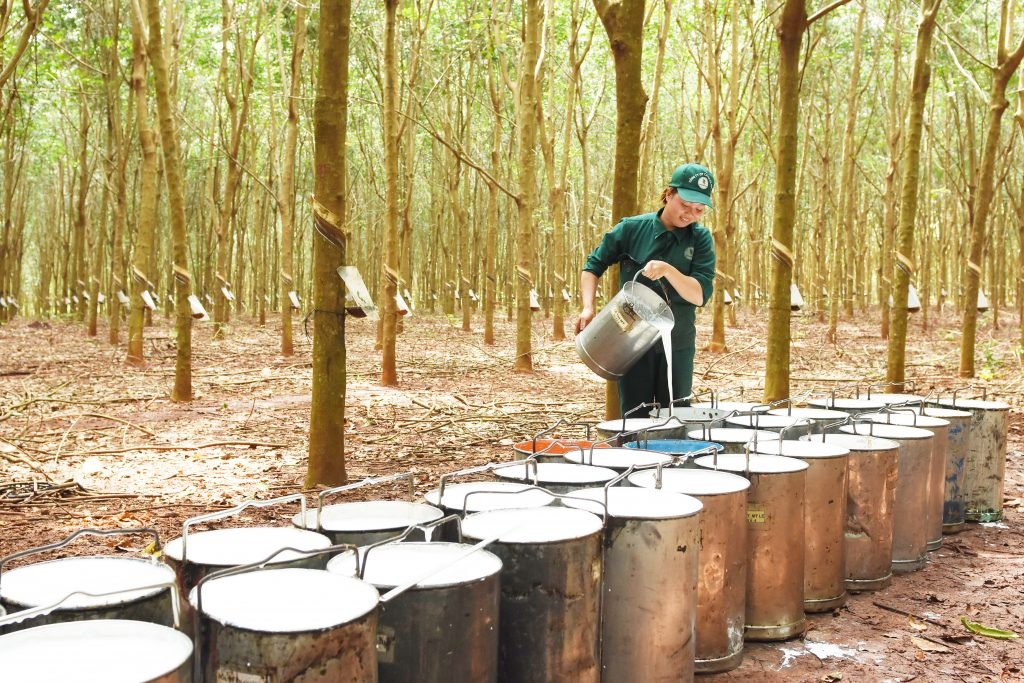 |
| Rubber industry aims for quality and sound solutions |
Rubber is one of Vietnam’s most valuable industrial crops, besides pepper, coffee, and cashew. The country’s rubber production is split between natural rubber, processed rubber products, and furniture made from rubberwood. The industry’s opportunities to expand its export market continue to expand through free trade agreements that have been signed or are under negotiation by the government.
Mr. Hoang Minh Chien, Deputy Director of Trade Promotion Department, Ministry of Industry and Trade, Ministry of Industry and Trade, said that after 18 years of implementing the program of voting national brands of seven brands, we have witnessed the continuous growth of many domestic enterprises.
By 2018, this had grown to 97, and this year we have registered 124 businesses and their brands.
At the first selection in 2008, we saw only 30 selected companies with their products. By 2018, this had grown to 97, and this year we have registered 124 businesses and their brands.
For example, the national brand recognized enterprise in 2018 achieved revenue of about 907 trillion VND (39.4 billion USD), export turnover reached 130 trillion VND (5.6 billion USD), contributing 85 trillion VND (3.7 billion USD) to the state budget and created 340,000 jobs.
Vu Ba Phu also said that, the Ministry of Industry and Trade has supported businesses in difficulty. After the first months of the health crisis, the domestic market was redefined.
Right from the beginning of the year, following the direction of the Government, the Ministry of Industry and Trade has worked with ministries, branches and localities to implement supply-demand activities across the country to remove difficulties for businesses in production. and distribution.
In addition, to support businesses with high quality brands, we have also been integrating selected brands into national promotions such as the Clean Food Program to vote Vietnamese products for local people.
The integration of such programs has helped grow the domestic market since the beginning of the year, despite the economic consequences of the pandemic. This shows that the communication, promotion and support efforts of the Ministry of Industry and Trade and its agencies so far have been effective.
Last year, Vietnam’s rubber industry has been focusing on both producing natural latex and improving the technology for its processing, while also developing catch-crop and high-tech rubber agriculture. Vietnam Rubber Group (VRG) has been fostering partnerships with local and foreign companies to find more markets. Up until last year, VRG has approved two high-tech agricultural zones and 13 high-tech projects with a total area of over 4,300 ha.
In addition, with plantations of over 410,000 hectares, VRG strives to create numerous employment opportunities and a stable source of income for approximately 80,000 workers. VRG is a spearhead company in Vietnam’s rubber industry whose role is to protect the environment and lead sustainable development by adopting policies to maintain biodiversity and restore natural forests. Last year, VRG had over 56,000ha of rubber forests legitimately certified as sustainable forests by the Vietnam Forest Certification System.
 |
As a result, Vietnam has the fifth-largest area for growing rubber trees in the world and the third-largest output in the world, only standing behind Thailand and Indonesia. Vietnam’s rubber production has been concentrating on sustainability, which includes credible investigation of rubber companies, plantations, and quality-centred production methods, as well as and corporate social responsibility. These actions have augmented Vietnam’s image in the global rubber industry as a reliable rubber producer and exporter.
The country exports rubber to more than 60 markets around the world. In 2020, rubber exports were estimated at 1.75 million tonnes, worth $2.38 billion, up 2.8 per cent in volume and 3.5 per cent in value compared to 2019, with an average export price of $1,362 per tonne, up 0.7 per cent compared to 2019.
Depending on each kind of product, different strategic trade partners are chosen for Vietnam. For instance, natural rubber was mainly exported to China, India, South Korea, Taipei, and the US. Europe also emerged as a new market for Vietnam’s natural rubber, with countries such as Germany, Spain, Italy, and the Netherlands all participating in the purchase. Vietnam’s main export products in 2020 were raw materials of latex, constituting about 78.4 per cent, while the remainder were processed products tyres, gloves, accessories, and soles of shoes. According to the Vietnam Rubber Association, in 2020, the country also exported a huge amount of rubberwood, whose export value hit $2.36 billion last year.
 |
| Casumina JSC is among the top 60 leading tyre producers worldwide |
Sustainable growth
The quality management system ISO9001 helps producers to reach high reliability. Local products such as tyres and tubes for cars and motorcycles meet the Japanese industrial standards, as well as US safety standards.
Casumina JSC is the only rubber and tyre company in Vietnam, and among the top 60 leading companies in this sector worldwide. Casumina’s products are diversified and in type and design and include automobile tyres, motorcycle tyres, tubeless tyres, and specialised tyres for the agricultural industry.
In June, Vietnam’s rubber exports reached 163,270 tonnes, worth $275.43 million, up 97.3 per cent in volume and 92.1 per cent in value compared to May, and 19.7 per cent more in volume and 69.6 per cent more in value compared to June 2020.
By the end of this year, global rubber output is expected to rise by 3-6 per cent on-year. Rubber consumption is predicted to expand at a rate of 4-5 per cent per year, resulting in an annual supply excess of 0.35-0.45 million tonnes due to the likely imbalance between supply and demand.
The consumption of automobiles and commercial vehicles is expected to grow at a compound annual growth rate (CAGR) of 6.8 and 6.1 per cent, respectively. Rubber tyre usage and production will rise in tandem with the rise in automotive consumption. The global automotive industry and demand for passenger automobiles have been constantly expanding, resulting in an increased need for rubber tyres. From 2017 to 2027, the global rubber tyre market is predicted to increase at a CAGR of 6.3 per cent, reaching a value of $645 billion by the end of 2027. As a result of this tendency, worldwide rubber prices have begun to rise again in Vietnam, with rubber exporters focusing on international automobile and other processing industries.
In the first six months of 2021, rubber exports reached $714,319 tonnes, worth $1.2 billion, up 48.2 per cent in volume and 88.5 per cent in price over the same period in 2020. Rubber prices are on the rise again, and the VRG is aiming for $1.17 billion in income this year, up from US$1.18 billion in 2020. However, due to the pandemic, VRG is more cautious about its proposed profits of $200 million for 2021.
 |
| In the first six months of 2021, rubber exports reached $714,319 tonnes |
Promoting national rubber
National brands are an important part of the long-term and unique trade strategy of the Vietnamese government. With the significance of the Vietnam Value Programme, rubber enterprises are not only recognised by the government and ministries, as well as other brands but are also on the path to creating a strong foothold in the domestic market and throughout the world.
The government considers the rubber industry a key factor for sustainable growth. Therefore, rubber manufacturers are aiming for product quality as the main competitive factor in their business strategy.
Many companies are promoting the application of modern, eco-friendly business processes that meet the requirements and regulations of competent authorities. Product quality is guaranteed by an advanced quality management system and is recognised in accordance with current legal regulations. The entire operating system is implemented according to national and international standards, and more and more modern machinery and equipment is utilised to improve the quality of products.
By participating in the 2020 Vietnam Value Programme, rubber companies could comprehensively evaluate their activities, business results, and branding strategies. With the three criteria, quality, innovation, and pioneering capacity, rubber enterprises have been improving their products to meet trademark criteria and qualify as national brands, possibly further into 2022.
Thus, the Vietnam Value Programme helps Vietnamese rubber manufacturers to assert their pioneering position, giving them more motivation to gradually realise future goals, diversify product models, and bring the best technology to the world.
The Vietnam Value Programme was approved by the prime minister with Decision No.253/2003/QD-TTg in 2003. The Ministry of Industry and Trade has been assigned to coordinate with other ministries and agencies to implement the programme.




